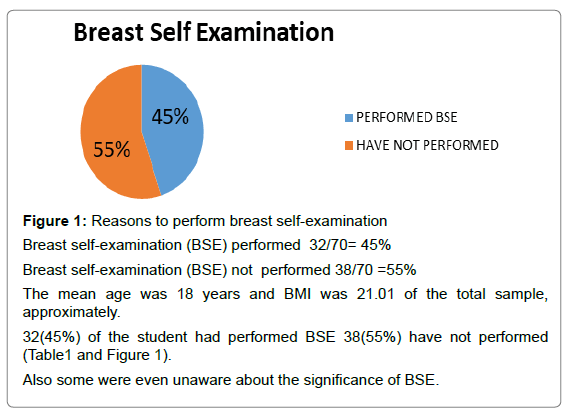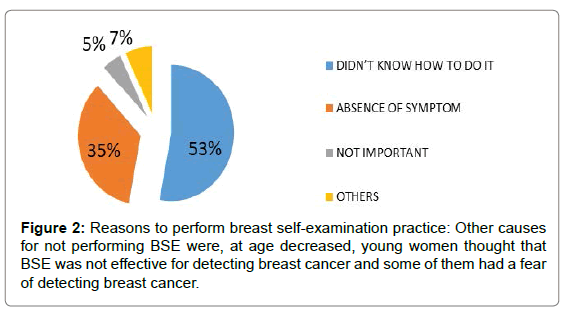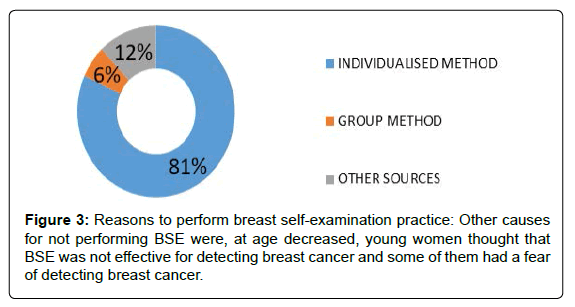Barriers to Perform Early Screening and Practice of Breast Self-Examination among High Risk Young Adults
Received: 20-Feb-2018 / Accepted Date: 18-Aug-2018 / Published Date: 26-Aug-2018 DOI: 10.4172/2168-9652.1000242
Keywords: Breast cancer; Breast self-examination; Early screening; High risk young adults
Introduction
Prevention is the excellent choice to outfit the increasing epidemic of breast cancer. In view of this, screening, early detection and public health awareness programs are foundation [1]. More than 90% of cases of breast cancer can be detected by women themselves, stressing the importance of Breast Self-Examination (BSE) as the key breast cancer detection mechanism [2]. The problem is that poor awareness of breast cancer symptoms has usually been associated with patient delay in seeking medical help resulting in reduced survival. There is a paucity of literature on removing barriers to breast screening among high risk young adults.
Breast cancer is to be one of the crucial public health problems around the globe [3]. There is an increase rates, in the developed world decreased in the developing countries like Asia, Middle East, and Africa [4]. Therefore, primary prevention and early diagnosis of breast cancer are vital. One of the major difficulties regarding breast cancer is lack of patients’ awareness [5]. Limitation in screening of breast selfexamination and mammography investigations is the principal issues.
Breast cancer is more prevalent malignancy and entitled the second leading cause of cancer deaths after lung cancer in Saudi Arabia [6]. Previous studies have reported lack of knowledge about breast cancer and its early detection which have a negative impact on the practice of breast self-examination among female [7]. This cancer transfer socioeconomic, emotional, and public health consequences. Breast cancer incidence rates in Arab women have increased during the last 24 years, but women are still being diagnosed with Breast Cancer at more advanced stages of the disease [8].
Aims and Objectives
To study the knowledge and practice for removing barriers to breast screening among high risk student population.
Materials and Methods
A cross sectional study was conducted in the Departments of Physiology, Chennai Medical College Hospital and Research Centre (SRM Group), Tamil Nadu, India.
Study design
Prior permission for the study was taken from the institutional scientific advisory committee and human ethics committee. After taking written informed consent, 70 subjects pursuing medical science courses were recruited for the present study after meeting inclusion and exclusion criteria. The study was conducted over a period of 12 months during 2015-16.
• Inclusion criteria:
1. Family history of breast cancer.
2. Age between 18-23 years.
• Exclusion criteria:
1. Family History of other cancer (except breast, ovarian & cervical cancer)
2. Those who were not willing to participate
3. Drug Usage
Procedure
Analytical cross-sectional study was conducted in department of physiology, in a tertiary care teaching hospital. After getting approval from institutional ethical committee, data collection were done by using self-administered questionnaires The subjects were selected by simple randomized sampling method based on family history, pre tested structured questionnaire. It consists of demographic data, practice of breast self-examination, reasons and barrier to perform BSE. The descriptive data were presented as frequencies and percentages. Statistical analysis was carried out by using IBM SPSS version 21.
The following parameters were used for data collection:
Self-administered questionnaires:
A. Knowledge on early warning signs of breast cancer
B. Knowledge about breast self-examination
C. Practice of breast self-examination
D. Barriers to perform breast self-examination practice
Anthropometry
1. BMI is calculated by the formula Weight (kg)/{Height (m)}2.
2. Obesity was assessed using BMI cutoff standard criteria; BMI between 18.5 and 24.9 is considered normal, 25 to 29.9, overweight, and equal to or higher than 30, is considered obese.
3. Waist to Hip Ratio (WHR).
Statistical Analysis
The data were entered in Microsoft Excel. Statistical analysis was carried out by using IBM SPSS version 21. Both descriptive and inference statistical analysis was used to analyse the data.
The descriptive data were presented as frequencies and percentages. All the statistical analysis was carried out at 5% level of significance and p value ≤ 0.05 was considered as significant.
Result
A cross-sectional and pre tested structured questionnaire study was conducted among 70 young women. It consists of demographic data, practice of breast self-examination, reasons and barrier to perform BSE.
Our study results were showed in the form of tables (Tables 1 and 2) and figures (Figures 1-3) as follows.
| I. Practice of breast self-examination- Questions | Response | N (32) | % |
|---|---|---|---|
| 1. Reason to perform BSE | Fear of breast cancer and other diseases | 22 | 69 |
| Family history of Breast cancer | |||
| Unusual appearance of the breast | 6 | 18.75 | |
| Others | 4 | 12.5 | |
| 2. Frequency of BSE performance | Daily and weekly | 2 | 6.25 |
| Monthly | 11 | 34.37 | |
| Yearly | 2 | 6.25 | |
| Occasionally | 17 | 53.12 |
Table 1: Reasons and frequency to perform breast self-examination.
| Questions | Response | N (70) | % |
|---|---|---|---|
| 1. Reasons not perform breast self-examination practice | I don’t think it is important | 3 | 4.2 |
| I don’t know how to do it | 37 | 52.85 | |
| I don’t have any symptom | 25 | 35.7 | |
| I know I can never have breast cancer | 0 | 0 | |
| Others | 5 | 7 | |
| 2. Barriers to perform breast self-examination practice: | lack of privacy | 6 | 8.5 |
| Pressure of work | 12 | 17 | |
| Doubt about its effectiveness | 3 | 4.2 | |
| Absence of symptom /diseases | 35 | 50 | |
| Forgetfulness | 14 | 20 |
Table 2: Reasons and barriers to not perform breast self-examination practice.
Figure 1: Reasons to perform breast self-examination
Breast self-examination (BSE) performed 32/70= 45%
Breast self-examination (BSE) not performed 38/70 =55%
The mean age was 18 years and BMI was 21.01 of the total sample,
approximately.
32(45%) of the student had performed BSE 38(55%) have not performed
(Table1 and Figure 1).
Also some were even unaware about the significance of BSE.
Discussion
Primary and secondary prevention of breast cancer, it is vital to identify high-risk young adults [9]. Primary prevention: The unmodifiable risk factors like, familial, personal, and age for breast cancer cannot be changed. Early introduction of regular exercise, reduction of weight are programme that can reduce the chance to cancer progression. Secondary prevention: Mammography Screening is recently the best available technique to diagnose breast cancer at an early stage. Based on solid evidence, formal instruction and encouragement to perform BSE leads to breast biopsies and diagnosis of most of the benign breast lesions [10]. This highlights the importance of promoting breast cancer awareness among young college students.
Nevertheless, the majority of the parameters investigated in this study depicts that relatively low measures in regard to medical students, which may be a predictor for the general population. Most of the previous studies have assessed the awareness levels among various counties, but most of these studies used parameters other than the variables employed in the presence study like various methods were available and to be advised appropriate method to perform BSE. The previous studies have reported that, the need for young women to be regularly taught BSE will increase their self-confidence and positive mentality [11]. Few controversies still persists about BSE remains an important technique for early screening and detection of breast cancer [12,13].
However, multiple studies were conducted in this context almost all of them recollect for implementing awareness strategies to increase the level of awareness among general population [14,15]. A significant number of women present with advanced stages of the disease due to inadequate information, knowledge and awareness of early screening measures. Previous studies showed lack knowledge about breast cancer screening, and few women performed screening for early detection purposes [16,17].
Conclusion and Recommendation
This study revealed that educating the youth on breast cancer is a potential strategy for dissemination of information and their knowledge to other female family members and friends in the society. In conclusion, most of the students preferred individualized method for removal of barriers to perform BSE than other method like breast model for teaching BSEs. Mothers and sisters should take responsibility and play a vital role in teaching of BSE of their girls and check regularly any pathology on their breast. Overall, our objectives could urge the healthcare providers and educationists to rethink their strategy of imparting knowledge to young adult on early diagnosis of breast cancer.
References
- Shallwani K, Ramji R, Ali TS, Khuwaja AK (2010) Self-examination for breast and testicular cancers: A community-based intervention study. Asian Pac J Cancer Prev 1: 145-148.
- Meijer-van Gelder ME, Look MP, Vries JB, Peters HA, Klijn JG, et al. (2001) Clinical relevance of biologic factors in male breast cancer. Breast Cancer Res Treat 68: 249-260.
- Xiaomei Ma, Herbert Yu (2006) Global Burden of Cancer. Yale J Biol Med 79: 85-94.
- Ahmed HG, Ali AS, Almobarak AO (2009) Utility of fine-needle aspiration as a diagnostic technique in breast lumps. Diagn Cytopathol 37: 881-884
- Shalini Saggu, Hasibur Rehman, Zahid K Abbas, Abid A Ansari (2015) Recent incidence and descriptive epidemiological survey of breast cancer in Saudi Arabia. Saudi Med J 36: 1176-1180.
- Radi SM (2013) Breast cancer awareness among Saudi females in Jeddah. Asian Pac J Cancer Prev 14: 4307-4312.
- Othman A, Ahram M, Al-Tarawneh MR, Shahrouri M (2015) Knowledge, attitudes and practices of breast cancer screening among women in Jordan. Health Care Women Int 36: 578-592.
- Segura PP, Fombella JPB, Lorenzo BP, MartÃn MR, Lopez PG (2014) SEOM guide to primary and secondary prevention of cancer: 2014. Clin Transl Oncol16: 1072-1078.
- Thomas DB, Gao DL, Ray RM, Wang WW, Allison CJ, et al. (2002) Randomized trial of breast self-examination in Shanghai: final results. J Natl Cancer Inst 94: 1445-1457.
- Freeman A, Scott C, Waxman A, Arcona S (2002)What do adolescent females know about breast cancer and prevention? J Pediatr Adolesc Gynecol 13: 96-98.
- Thomas D, Gao D, Ray R (2002) Randomized trial of breast self-examination in Shanghai: Final results. J National Cancer Institute 94: 1445-1457.
- Anderson B (2007) Guideline implementation for breast healthcare in low-income and middle income countries: Overview of the Breast Health Global Initiative Global Summit. Cancer 113: 2221-2243.
- Madkhali NA, Santin O, Noble H, Reid J (2016) Understanding breast health awareness in an Arabic culture: Qualitative study protocol. J Adv Nurs 72: 2226-2237.
- Abolfotouh MA, Bani Mustafa AA, Mahfouz AA, Al-Assiri MH, Al-Juhani AF, et al. (2015) Using the health belief model to predict breast selfexamination among Saudi women. BMC Public Health 15: 1163.
- Almutairi KM, Ahmad M, Vinluan JM, Almutairi A (2016) Random cross-sectional determination of the level of awareness among female saudi patients about breast cancer. J Cancer Educ 31: 131-135.
- Othman A, Ahram M, Al-Tarawneh MR, Shahrouri M (2015) Knowledge, attitudes and practices of breast cancer screening among women in Jordan. Health Care Women Int 36: 578-592.
Citation: Jeyakeerthi S, Subbu Lakshmi M, Niranjana D, Rajajeyakumar M, Janitha (2018) Barriers to Perform Early Screening and Practice of Breast Self-Examination among High Risk Young Adults. Biochem Physiol 7: 242. DOI: 10.4172/2168-9652.1000242
Copyright: © 2018 Jeyakeerthi S, et al. This is an open-access article distributed under the terms of the Creative Commons Attribution License, which permits unrestricted use, distribution, and reproduction in any medium, provided the original author and source are credited.
Share This Article
Recommended Journals
Open Access Journals
Article Tools
Article Usage
- Total views: 5070
- [From(publication date): 0-2018 - Apr 05, 2025]
- Breakdown by view type
- HTML page views: 4199
- PDF downloads: 871



